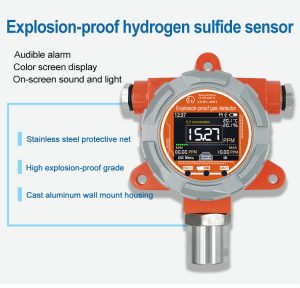Air pollution has become a pressing global issue, impacting human health and the environment. Effective monitoring of air quality is crucial in understanding pollutant levels, identifying sources of pollution, and implementing targeted mitigation strategies. Gas sensors have emerged as vital tools in improving air quality monitoring systems. By detecting and measuring various pollutants, gas sensors enable real-time and accurate monitoring, leading to better air quality management. This article explores how gas sensors are revolutionizing air quality monitoring, enhancing public health, and facilitating sustainable environmental practices.

-
Understanding Gas Sensors:
Gas sensors are devices designed to detect and measure the concentration of specific gases present in the atmosphere. These sensors employ various technologies, including electrochemical, infrared, and semiconductor-based sensors. Each sensor type is tailored to detect specific gases, such as carbon monoxide (CO), nitrogen dioxide (NO2), ozone (O3), sulfur dioxide (SO2), and volatile organic compounds (VOCs). Gas sensors capture data on pollutant levels, enabling continuous monitoring and analysis.
-
Real-Time Monitoring:
Gas sensors provide real-time monitoring capabilities, allowing for immediate detection and response to changes in pollutant concentrations. Traditional air quality monitoring systems rely on periodic sampling and laboratory analysis, resulting in delayed information and limited spatial coverage. With gas sensors, real-time data is continuously collected, providing a comprehensive view of air quality trends and fluctuations. This timely information aids in identifying pollution hotspots, assessing exposure risks, and implementing swift mitigation measures.
-
Identifying Pollutant Sources:
Gas sensors play a critical role in identifying the sources of air pollution. By continuously monitoring pollutant concentrations in different locations, patterns and trends can be analyzed to pinpoint emission sources accurately. This information helps authorities and policymakers develop targeted strategies to reduce emissions from industrial facilities, transportation networks, and other pollution-intensive sectors. By addressing specific pollution sources, effective and efficient mitigation measures can be implemented, leading to significant improvements in air quality.
-
Portable and Wireless Sensor Networks:
Advancements in gas sensor technology have resulted in the development of portable and wireless sensor networks. These networks consist of multiple gas sensors strategically deployed across a region or city. Portable sensors can be carried by individuals, enabling personal exposure monitoring and mapping. Wireless networks provide extensive coverage and facilitate data sharing among various stakeholders, including regulatory agencies, researchers, and the public. The availability of portable and wireless sensor networks enhances the spatial resolution of air quality data, enabling localized interventions and community engagement.
-
Integration with IoT and Big Data Analytics:
Gas sensors are increasingly integrated into Internet of Things (IoT) platforms and big data analytics systems. IoT connectivity enables seamless communication between gas sensors, data storage centers, and decision-making platforms. By collecting and analyzing vast amounts of real-time data from gas sensors, environmental patterns and correlations can be identified. This integration facilitates predictive modeling, allowing for early detection of potential pollution events and informed decision-making in response to changing air quality conditions.
-
Community Engagement and Citizen Science:
Gas sensors provide opportunities for community engagement and citizen science initiatives. With the availability of affordable and accessible gas sensors, individuals and communities can actively participate in monitoring air quality in their surroundings. Citizen science projects empower citizens to collect data, contribute to air quality databases, and collaborate with researchers and policymakers. This bottom-up approach fosters public awareness, encourages responsible behavior, and promotes collective actions to tackle air pollution effectively.
-
Environmental Impact Assessments:
Gas sensors support environmental impact assessments by providing accurate data on pollutant levels near industrial facilities, construction sites, and other potential pollution sources. By measuring and monitoring emissions in real-time, industries can assess the effectiveness of pollution control measures and identify areas for improvement. Gas sensor data also aids in compliance monitoring, enabling regulatory bodies to ensure adherence to air quality standards and regulations.

Conclusion:
Gas sensors are revolutionizing air quality monitoring by providing real-time and accurate data on pollutant concentrations. These sensors enhance our understanding of air pollution sources, enable targeted mitigation strategies, and empower individuals and communities to actively engage in air quality management. The integration of gas sensors with IoT platforms and big data analytics systems facilitates advanced data analysis and predictive modeling, helping authorities make informed decisions and implement effective pollution control measures. As we continue to tackle the global challenge of air pollution, gas sensors will play a pivotal role in improving air quality, protecting public health, and promoting sustainable environmental practices.
 : +86 155 8830 2704
: +86 155 8830 2704 : jxdziot@gmail.com
: jxdziot@gmail.com
